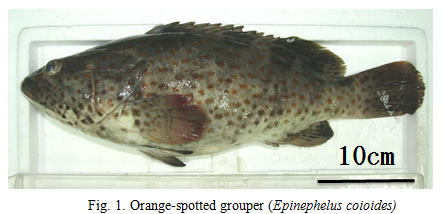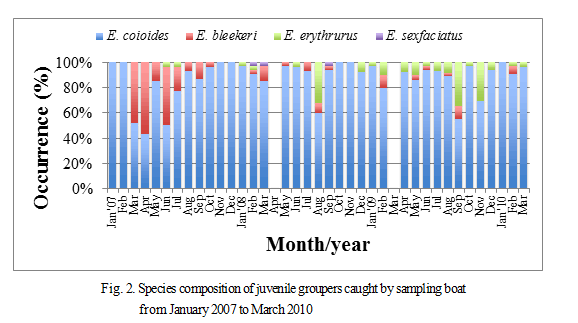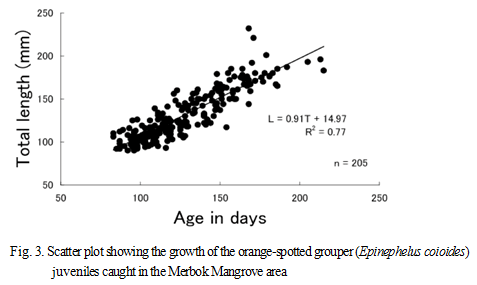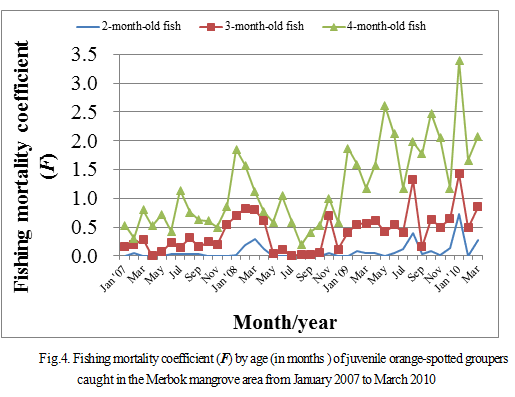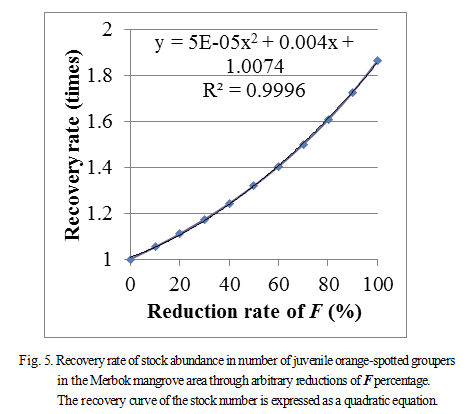Stock assessment and management of juvenile orange-spotted grouper (Epinephelus coioides ) at a tropical mangrove brackish area in Peninsular Malaysia
Description
Juvenile orange-spotted groupers (Fig. 1), the most commercially important fish in the tropics, are usually harvested from brackish waters for use as aquaculture seed, but the actual fishing situation is unclear. In this research, the actual fishing situation of juvenile grouper-species fish was clarified by collecting fishing statistics from the Merbok Mangrove brackish waters in the northwestern coast of Peninsular Malaysia. Also, stock assessment of the juvenile orange-spotted grouper was conducted using fishing statistics and biological analysis. Furthermore, a stock management model for juvenile orange-spotted groupers was constructed and an effective strategy for a sustainable stock management system was proposed to relevant agencies of the Malaysian government.
An investigation on the actual fishing situation of juvenile orange-spotted groupers was conducted in the Merbok Mangrove brackish waters of Malaysia from January 2007 to March 2010. The results showed that they were dominant through all those years (Fig. 2). Spawning behaviour of juvenile orange-spotted groupers was determined based on otolith age-in-days analysis. It was observed that juvenile fish born in the sea migrated into the mangrove brackish waters at the age of two months, stayed there for three to five months, and then moved out to coastal regions by the age of seven months. The relationship between the age in days and total length of the juvenile orange-spotted groupers in the mangrove brackish waters is expressed in the following single regression formula, called the growth formula, where total length=0.91 x age in days + 15.0 (R2=0.77) (Fig. 3).
The results of the stock assessment conducted on the juvenile orange-spotted groupers in the Merbok Mangrove brackish waters showed that the fishing mortality coefficient (F) (coefficient expressing the size of the rate of decline of the number of stock with catching as the cause of death) of fish over four months old increased drastically from September 2008. It was affirmed that juvenile orange-spotted groupers in the same brackish waters were overexploited (Fig. 4). By contrast, stock recovery rate simulation results indicated that a reduction in fishing effort could help expectations for stock recovery. Additionally, the stock recovery rate increased quadratically in association with the reduction in the fishing mortality coefficient (Fig. 5).
With this research, it was established that the mangrove brackish waters are habitats critical to the growth of juvenile orange-spotted groupers. Based on recovery rate model simulation, fishing prohibition would be the most effective method of stock management. If fishing prohibition measures are implemented, up to four times the current amount of juvenile fish could be supplied to the coastal regions. It was estimated that the number of out-migrating stock would be approximately 20,000 fishes per month. These results is expected to be used as fundamental data for stock management in Malaysia.
Figure, table
- Affiliation
-
Japan International Research Center for Agricultural Sciences Fisheries Division
- Classification
-
Research
- Research project
- Program name
- Term of research
-
FY 2010(FY 2006-FY 2010)
- Responsible researcher
-
Yamamoto Toshihiro ( National Research Institute of Fisheries Science )
Morioka Shinsuke ( Fisheries Division )
KAKEN Researcher No.: 40455259Hanamura Yukio ( National Research Institute of Fisheries Science )
KAKEN Researcher No.: 50371951Man Alias Bin ( Fisheries Research Institute, Malaysia )
Ean Chee Phaik ( Fisheries Research Institute, Malaysia )
Siow Ryon ( Fisheries Research Institute, Malaysia )
- ほか
- Publication, etc.
-
Yamamoto et al. (2010) Malay. Fish. J. 9: 57-70
Yamamoto et al. (2012) JIRCAS Working Report, 75: 59-67
- Japanese PDF
-
2011_18_A4_ja.pdf126.02 KB
- English PDF
-
2011_18_A4_en.pdf313.54 KB

